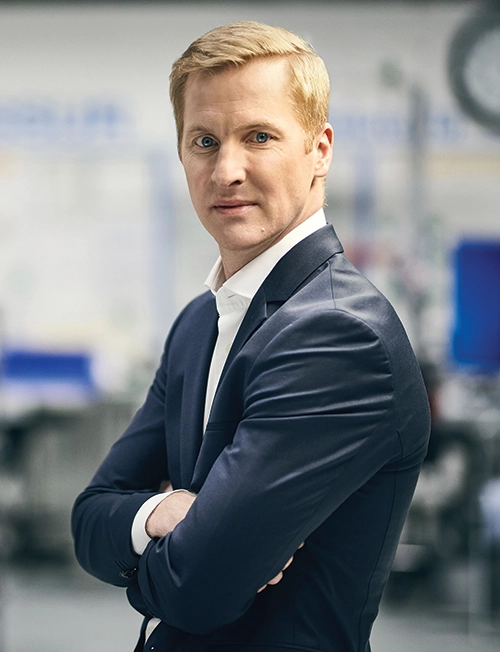Q+A With Sveinn Sölvason

When Sveinn Sölvason became Össur’s CEO last April, it marked the company’s first leadership change in a generation. Sölvason’s predecessor, Jon Sigurdsson, took the helm in 1996 and presided over the company’s transformation from a family-held firm into a global industry leader. His 26-year reign witnessed one technological breakthrough after another, as Össur helped drive innovation in running blades, computer-augmented components, powered legs, and other ability-enhancing devices.
All those trends figure to remain as dynamic ever on Sölvason’s watch. In addition to managing them, he’ll need to attend to emerging reforms in the limb-care industry that will affect patient care models, payment systems, consumer options, and data utilization. It’s a pivotal moment that’s ripe with possibility but not without peril. This spring, at Össur’s global investor summit, Sölvason explained that the company’s core challenge is to evolve from a product-driven model to a patient-driven model—the topline objective of the five-year Growth ’27 plan unveiled there.
Shortly after that event, Amplitude had a chance to talk with Sölvason about what American consumers can expect in the next half-decade. You can read more of his thoughts in the June edition of The O&P EDGE, Amplitude’s partner publication.
AMPLITUDE: Within the US, there’s a lot of frustration among amputees with the payment model for limb care. As patient care becomes more central to Össur’s growth in this market, how would you assess our model.
Sölvason: The adoption of high-end devices or high-quality prosthetics is reasonably good in the US compared to many other countries, but we still believe it’s way too low. If you were to look at a payment model that’s based on outcomes, I think that would drive an increased ability for more amputees to have access to better products. The cost savings are there, and that’s exciting.
One of the biggest tasks in fighting for better access to mobility devices is to explain why it’s a good investment for the system to pay for good solutions. When individuals are more mobile, they’re less likely to have other health problems. And I think we as an industry need to do more to capture the right data and put that in front of decision-makers. The more people that are using bionics and advanced prosthetic solutions, the more you’ll have a healthier and less costly patient population. That is the health economics [of prosthetics]. We need to constructively influence the payers to look at it that way.
What are the biggest hurdles you see in getting that message across and making it stick?
In the US market, the payer landscape is fragmented. There are multiple stakeholders just within Medicare. Then you have the whole Medicaid system, and then all the complexities around private insurance as well. That’s compared against some of the systems on our side of the pond, where you have one-payer systems and, perhaps, more structured protocols to follow to create access to new technology.
In addition to the fragmented payer system, do you see Össur addressing any of the other inefficiencies in our system? For example, different clinical specialties are siloed. Demographic inequity is a major problem. There are barriers related to transportation, housing, language, and so forth. As Össur gets more deeply involved in frontline care delivery, how can it untangle some of those knots?
That goes back to the logic for why we think it makes sense for us to operate in the whole chain, everything from product development to patient care. That drives a better understanding for the whole process, and it enables us to better help individuals navigate a complex health system.
Historically, we’ve just been focused on a single event—when a prosthesis is provided. But in all 364 other days of the year, people need to maintain their mobility levels and understand how their solution is working for them. There are a lot of things that we can do differently and provide more value in that regard, and our goal is to find ways to do that.
Some health organizations are going toward a multidisciplinary model of limb care in which the prosthetist is part of an integrated team that includes a physical therapist, a mental health counselor, maybe a pain management specialist—a variety of different practitioners who all coordinate care. Is that the sort of value-add Össur is looking into?
You’re spot-on. This is going back to what individuals need. We’re proud of our technology, but to maintain mobility levels you need all these things. They are all important. We’ve been experimenting with different models, especially back to the rehabilitation side. If we look at how the industry may develop, I think you’ll start to see more holistic models that will incorporate these aspects to serve patients in a more holistic manner.
What’s your opinion of the potential for 3D-printed sockets to broaden patients’ access to prosthetics? A lot of the evidence suggests that 3D-printed sockets, as opposed to carbon fiber, can serve a higher number of patients for a lower cost. In essence, it can put more devices on more limbs. Is that a high priority for Össur?
It is a priority for us. 3D printing is going to play a role in how the industry will develop in the short to medium term. I have no doubt about that. We’ve looked at and are experimenting with 3D printing, especially on the socket side. It’s important for the industry to increase productivity in the developed part of the market, and 3D printing can certainly do that. But I think 3D printing is even more important when it comes to creat-ing more access in less developed markets, because most amputees in the global amputee population don’t get any limb care at all. That’s where the industry needs to be innovative and develop a business model that helps us find these patients and deliver legs. I think that’s where 3D printing can play a big role.
Another thing our readers get very excited about is neuroprosthetics, or devices that can be controlled very intuitively and maybe provide a sensory return. When do you think there will be a commercial mass-market device that has all these features integrated into it?
We have been working on what we refer to as mind-controlled prosthetics for a while, and principally implanting sensors that communicate with our prosthetic components. We are currently doing clinical testing in Europe. So intuitive control is going be the next step in evolution when it comes to increased function. There are different ways to achieve that, and we are working on several fronts there. It’s something we’ve been investing in for years. I’m hesitant to say when we will have a commercial product available, but it’s out there.
The best estimates suggest that more than half of US amputees don’t receive a prosthesis. Where do you see the greatest potential for improving that percentage?
If you look at the specifics of the US system, only amputees who are considered “active” are eligible for bionics, for example. But the biggest part of the amputee population therefore does not have access to the technology that would be most beneficial for their day-to-day lives and their overall health. So that’s obviously something in the system that needs to be different so that it creates access for the population. There’s opportunity for improvement, for sure. How we go about that is another story. But I’m confident that it’s a matter of time. Medicare has made some comments historically about their view that bionics would be of benefit for the K2 population. So it’s our job as an industry to fight for it.
Since you brought up K-levels: Have we reached the point where we need a different model? The K2 population is a very diverse population. Do we need more nuanced categories, or even a whole new way of cataloging people, so that more people who could potentially benefit from advanced devices can actually get them?
The K-levels provide a framework, but I think it needs to be reworked. The point of departure needs to be what outcomes we are after, and what benefit we can show to justify payment for better devices—particularly for the elderly, less active population, which doesn’t have access today. So my answer is a firm yes: We need to figure out a better way to create more access for that patient group. Absolutely.
I’ve had people express concern that if their clinic is purchased by Össur (or by Ottobock, which also is investing in patient care), over time clinicians will become focused on promoting the owners’ product line, at the expense of patient need. What steps is Össur taking to help consumers maintain trust in their prosthetist?
I’m really glad you asked this question, and I understand perfectly well why people have a concern around that. Our view is simple: We will always prioritize clinical autonomy for our clinicians to choose the right solution for their patients. You can ask our clinicians in the clinics we own, and they’ll confirm this. Because at the end of the day, our business interest is to maintain our patients’ willingness to interact with us. If we compromise on that, that’s not good for our business.
We have great products, and we’re proud of our products, but we will never force utilization. We own clinics because we believe that will enhance our ability to be good on product development, and it will enhance our ability to influence payment systems in a constructive way that increases access for patients. Being a pure component manufacturer is very limiting versus having a seat at the table and interacting with the entities that are paying for the product. So it’s our belief that this will drive value for our patients, and we wouldn’t ever compromise on that.




